This section describes the implementation of each
of the cleaner production projects, and the results. Detailed
evaluation of each of the projects was not conducted prior to
implementation. The projects were deemed by Bonlac to provide
an excellent opportunity to demonstrate the benefits of cleaner
production.
3.1 CIP CHEMICALS CHANGEOVER
3.1.1 Project Evaluation
and Implementation
As noted in an earlier section, Bonlac decided that
no detailed evaluation was required of the opportunity as the
perceived economic and environmental benefits were well understood.
Implementation of the project was straight forward
with a simple swap of the acid wash chemical from the existing
nitric/phosphoric acid wash chemical to Stabilon®;. The swap
required operators to be aware of the different water make-up
required to use Stabilon® and its better-cleaning properties.
The impact of the Stabilon® project was to be
assessed by monitoring the waste water quality and volume discharged
from the facility.
3.1.2 Results
Bonlac made the change over to Stabilon® in
their CIP process in September 1995.
Prior to change over to Stabilon® 200 litres
of nitric/phosphoric acid was used each day in the CIP process.
However, only 150 litres of Stabilon® is used to achieve
the same level of cleaning. The need for less cleaning detergents
also reduces the quantity cleaning water used, effluent produced
and in electricity usage to power the cleaning pumps. Phosphorus
and nitric levels in the waste water discharged to the waste water
treatment facility are also expected to decrease.
The use of Stabilon® decreased the normal 6
hour CIP wash time by 25 %, to 4.5 hours. This effectively increased
the available cheese making time by 1.5 hours per day. Bonlac
continue to perform a full acid wash about once a week for control
purposes. The introduction of Stabilon® to the CIP process
increased the available time for the production of cheese by approximately
9 hours per week or 8%.
TABLE 1
DAILY MARGINAL COSTS ASSOCIATED WITH CHANGE OVER
TO STABILON®
| | Cost ($/day)
|
| Costs
|
- Stabilon® Consumption
| -571.50
|
| Savings
|
- Reduced Nitric/Phosphoric Acid Usage
| 220.00
|
- Extra Production - Cheese
| 382.50
|
- Extra Production - Whey
| 220.00
|
- Reduced Electricity Consumption
| 40.00
|
- Reduced Cleaning Water Consumption
| 20.80
|
| NET BENEFIT |
$311.80
|
As illustrated in Table 1, change over to Stabilon®;
yielded an overall net savings of $311.80 per day. The savings
are expected to increase as the use of Stabilon® detergent
is refined.
The expected reduction in the total quantity of waste water volume
did not occur. However, cleaning with Stabilon® created
additional time available for cheese production and therefore
the volume of waste water increased accordingly. An attempt was
made to relate the volume of waste water discharged to the waste
water treatment facility, to the amount of cheese produced. The
results were compared with data from the 1994/1995 production
season to account for seasonal variation. The results are shown
in Figure 1 and Figure 2.

Figure 1 indicates that in 1995/1996 season, despite the
changeover to Stabilon®;, a clear reduction in effluent discharged
per tonne of cheese produced was not obvious. The results display
a general and gradual decline in waste water discharged from the
cheese room per tonne of cheese produced. However, it is clear
that the waste water generated was greater in December 1996 and
January 1996, compared with the previous season. A reduction
is evident in February and March 1995, but this is subsequently
followed with another increase.
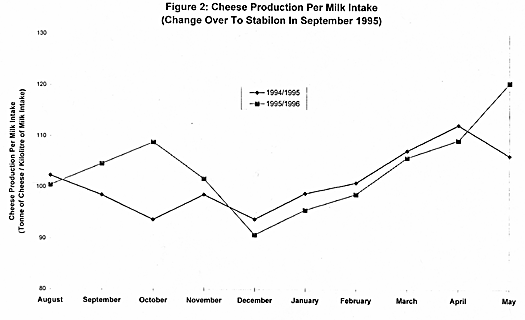
Figure 2 indicates that in the early stages of the 1995/1996
season, more milk was used to produce cheese relative to the 1994/1995
season. This was followed by a slight improvement between December
1995 and April 1996. This variation indicates that other factors
have influenced the waste water volumes discharged from the facility.
Although this study did not demonstrate a reduction in waste
water discharge, it is expected that the volume of waste water
will decrease during the next season as the use of Stabilon®;
is refined.
Although the expected reduction in waste water did not eventuate,
two main benefits from the use of Stabilon® were observed.
Firstly, Bonlac have increased their cheese production rate without
major capital works or plant expansion. Secondly, because Stabilon®;
replaces the use of nitric and phosphoric acids, the nitrogen
and phosphorus nutrient loading in the waste water released to
the waste water treatment facility is expected to decreased.
Such reductions in the environmental nutrient loading will decrease
the risk of algal growth and eutrophication of the receiving waterways.
3.2 DIVERSION OF WASTE WATER TO FARM
IRRIGATION
3.2.1 Project Evaluation
As with other cleaner production initiatives identified at the
Bonlac Stanhope no quantitative economic or environmental evaluation
was made of the diversion of wastewater to farm irrigation.
Economic benefits of the initiative were perceived as decreased
costs associated with the wastewater treatment plant and sales
of the crop grown on the irrigated land.
Environmental benefits were perceived as a decrease in hydraulic
load to and from the wastewater treatment plant, leading to a
more efficient wastewater treatment plant and a decrease in the
impact of the receiving waterways.
3.2.2 Project Implementation
To implement the project an irrigation system needed to be installed
so the proposed diversion system could be trialled.
The wastewater can only be diverted for farm irrigation when there
is sufficient capacity for the irrigated land to sustainably absorb
the wastewater. Therefore, the capacity of the land to accept
the wastewater depends on the season and the amount of rainfall.
The diversion of waste water to farm was scheduled to commence
in December 1995. The farmland is owned by Bonlac.
3.2.3 Results
Diversion of the three low ionic waste water streams from the
whey room, demineralisation plant, and evaporators to nearby farmland
was initially delayed whilst the land was prepared for irrigation
and subsequently commenced in February 1996.
A ten day trail was performed to commission the irrigation facilities
installed, as well as demonstrate the potential reduction in waste
water transported to the waste water treatment facility. The
results of the trial are represented in Figure 3 and Figure
4.
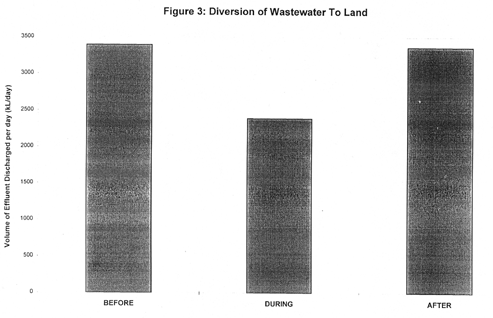
Figure 3

Figure 4
Before diversion commenced, a total of about 3,390 kL of waste
water was sent to the waste water treatment facility each day.
During the diversion, the flow reduced to an average of 2,390
kL per day, representing an approximate 30 % reduction of effluent
discharged into Deakin Drain, and ultimately into the Murray River.
Figure 4 illustrates the waste water discharged to the
waste treatment facility per tonne of cheese produced. This was
done to demonstrate that the effluent reduction was due to the
diversion trials, rather than changes in the production rate.
The diversion will occur continuously commencing in the next cheese
production season. The scheduling of the diversion process will
strongly depend on seasonal climatic patterns including rainfall,
relative humidity and temperature. However, the savings obtained
during the optimum weather conditions will greatly reduce the
loading on the existing waste treatment facility.
Bonlac intend to grow millet grass on the irrigated farmland,
and sell it as fodder for cattle.
In summary, the major benefit of the project is a significant
reduction in the volume of waste water processed by the waste
water treatment facility and an increase in the efficiency of
the facility. This reduction translates into a decrease in the
hydraulic loading of waste water entering the Deakin Drain directing
water to the Murray River. The secondary benefit is the expected
earnings from the millet grass to be grown on the farmland.
3.3 SOLIDS SCREENING FROM CHEESE ROOM
WASTE WATER
3.3.1 Project Evaluation
No detailed quantitative evaluation was undertaken of the cleaner
production initiative prior to implementation.
The economic benefits of the initiative were identified as a decrease
in lost cheese, thereby effectively increasing plant productivity,
and a decrease in wastewater treatment costs.
The environmental benefits were perceived as a more efficient
use of resources and a decrease in suspended solid and organic
load to the wastewater treatment plant and the local receiving
waterway.
3.3.2 Project Implementation
Two methods were proposed for reducing the quantity of suspended
solids in the cheese room wastewater.
One method proposed to capture solids from the cheese room waste
water involved installing screens in the cheese room waste water
outlet, thereby reducing the organic load on the waste water treatment
facility. The recovered solids were to be re-processed if free
of contamination. Installation of the screens was scheduled for
December 1995.
In addition to the screens, Bonlac proposed to install two large
settling tanks in the whey room, with the intent of removing cheese
solids from the process rinse water. This system was considered
less likely to result in microbial contamination of the cheese.
Again the recovered solids could be re-used in the cheese making
process and the wastewater from cheese making plant would have
lower suspended solids. The settling tanks were to be installed
and operational by the beginning of February 1996.
To monitor the impact of the cheese solids removal project, a
sampling and testing program was set up to monitor total suspended
solids (TSS) in the effluent streams leaving the cheese room.
3.3.3 Results
Screens to capture solids in the cheese room effluent discharge,
were installed in December 1995. Total suspended solids (TSS)
in the discharge is plotted in Figure 5 and TSS as a function
of cheese production is plotted in Figure 6. A significant
decrease was noted in the first month of operation, both in absolute
terms and as a function of the tonnage of cheese produced. A
gradual increase is clearly evident beyond January 1996. The
cause of this increase has yet to be determined, but the TSS levels
are still markedly lower than the concentration of suspended solids
in the waste water prior to the installation of the screens.
The settling tanks were installed in late February 1996 although,
because of time constraints, only one tank was commissioned.
Bonlac personnel reported that the optimum operating conditions
for the tank were still being investigated. This could explain
the reduced effectiveness of the settling tank in removing the
solids loading in the waste water discharge and the gradual but
eventual increase in the solids content of the waste water. However,
both tanks will be operational and fully optimised for the next
cheese production season. It is expected that the TSS in the
waste water discharge will decrease during the next season.
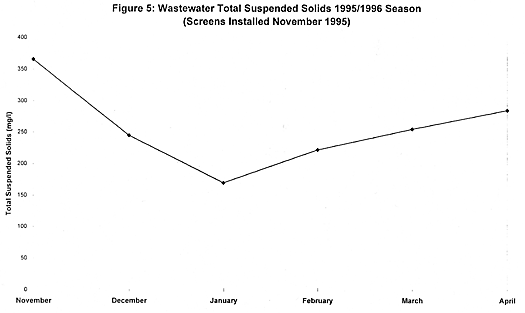
Figure 5
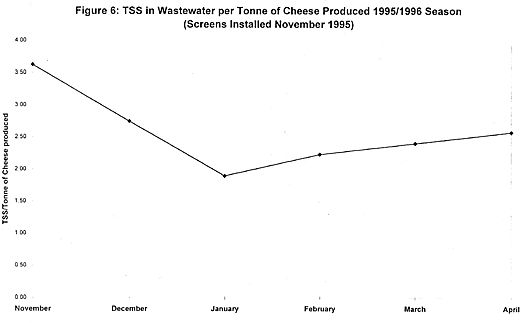
Figure 6
The estimated breakdown of costs associated with the capture of
cheese solids from the whey leaving the cheese room follows:
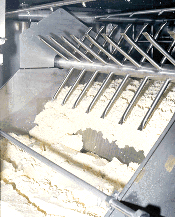 3.0 CLEANER PRODUCTION INITIATIVES
3.0 CLEANER PRODUCTION INITIATIVES





